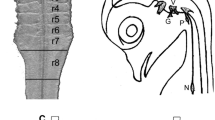Summary
In chick embryos, on the 3rd day of incubation, the developing right wing bud was removed. One group of the operated embryos was treated with a daily dose of 20 μg purified nerve growth factor (NGF) from the 5th day of incubation and sacrificed on the 12th day. The other group was sacrificed on the 12th day of incubation and served as control. NGF was also administered to intact, unoperated embryos for comparison. The size of the dorsal root ganglia in segments 13–16 innervating the wings, were estimated and the number of surviving dorsal root ganglion cells counted both on the right (operated) and left (intact) sides. Although NGF brought about an increase in the size of the ganglia and an increase in the number of dorsal root ganglion cells bilaterally, it was not able to prevent excessive cell death of dorsal root ganglion cells on the operated side. The number of surviving neurons in the dorsal root ganglia on the operated side in embryos with or without NGF administration was only about 30–50% of the number of the intact side.
These results show that cell death induced by target removal cannot be offset by NGF administration. It is concluded that NGF may act as a growth promoting agent for developing sensory neurons but other peripheral trophic factor/s are also needed for the maintenance and survival of dorsal root ganglion cells.
Similar content being viewed by others
References
Abrahamson IK, Murdoch SY, Rush RA (1984) The effect of culture on the neuronotropic activity of avian smooth muscle. Int J Dev Neurosci 2:229–239
Ayer-LeLievre CS, Ebendal T, Olson L, Seiger A (1983) Localization of nerve growth factor-like immunoreactivity in rat nervous tissue. Med Biol 61:296–304
Barde Y-A, Edgar D, Thoenen H (1980) Sensory neurons in culture: changing requirements for survival factors during embryonic development. Proc Natl Acad Sci USA 77:1199–1203
Brunso-Brechtold JK, Hamburger V (1979) Retrograde transport of nerve growth factor in chick embryo. Proc Natl Acad Sci USA 76:1494–1496
Carr VM, Simpson SB (1978a) Proliferative and degenerative events in the early development of chick dorsal root ganglia. I. Normal development. J Comp Neurol 182:724–740
Carr VM, Simpson SB (1978b) Proliferative and degenerative events in the early development of chick dorsal root ganglia. II. Responses to altered peripheral fields. J Comp Neurol 182:741–756
Ebendal T, Norrgren G, Hedlund K-O (1983) Nerve growth-promoting activity in the chick embryo: quantitative aspect. Med Biol 61:65–72
Ebendal T, Olson L, Seiger A (1983) The level of nerve growth factor as a function of innervation: A correlative radioimmunoassay and bioassay study of the rat iris. Exp Cell Res 148:311–317
Ebendal T, Olson A, Seiger A, Hedlund K-O (1980) Nerve growth factor in the rat iris. Nature 286:25–28
Hamburger V (1934) The effects of wing bud extirpation on the development of the central nervous system in chick embryos. J Exp Zool 68:449–494
Hamburger V (1939) Motor and sensory hyperplasia following limb bud transplantation in chick embryos. Physiol Zool 12:268–284
Hamburger V (1958) Regression versus peripheral control of differentiation in motor hypoplasia. Am J Anat 102:365–410
Hamburger V, Hamilton H (1951) A series of normal stages in the development of the chick embryo. J Morphol 88:49–92
Hamburger V, Keefe EL (1944) The effects of peripheral factors on the proliferation and differentiation in the spinal cord of chick embryos. J Exp Zool 96:223–242
Hamburger V, Levi-Montalcini R (1949) Proliferation, differentiation and degeneration in the spinal ganglia of the chick embryo under normal and experimental conditions. J Exp Zool 111:457–502
Hamburger V, Yip JW (1984) Reduction of experimentally induced neuronal death in spinal ganglia of the chick embryo by nerve growth factor. J Neurosci 4:767–774
Hamburger V, Brunso-Brechtold JK, Yip JW (981) Neuronal death in the spinal ganglia of the chick embryo and its reduction by nerve growth factor. J Neurosci 1:60–71
Herrup K, Shooter EM (1975) Properties of β-NGF receptor in development. J Cell Biol 67:118–124
Korsching S, Thoenen H (1983a) Nerve growth factor in sympathetic ganglia and corresponding target organs of the rat: correlation with density of sympathetic innervation. Proc Natl Acad Sci USA 80:3513–3516
Korsching S, Thoenen H (1983b) Quantitative demonstration of the retrograde axonal transport of endogenous nerve growth factor. Neurosci Letts 39:1–4
Lees G, Chubb I, Freeman C, Geffen L, Rush RA (1981) Effect of nerve activity on transport of nerve growth factor and dopamine β-hydroxylase activity in sympathetic neurones. Brain Res 214:186–189
Levi-Montalcini R, Angeletti PN (1963) Essential role of the nerve growth factor in the survival and maintenance of dissociated sensory and sympathetic nerve cells in vitro. Dev Biol 7:653–659
Levi-Montalcini R, Angeletti PN (1968) Nerve growth factor. Physiol Rev 48:534–569
Levi-Montalcini R, Hamburger V (1951) Selective growth stimulating effects of mouse sarcoma on the sensory and sympathetic nervous system of the chick embryo. J Exp Zool 116:321–362
Mobley WC, Schenker A, Shooter EM (1976) Characterization and isolation of proteolytically modified nerve growth factor. Biochemistry 15:5543–5551
Prestige MC (1970) Differentiation, degeneration, and the role of the periphery: Quantitative considerations. In: FO Schmitt (ed) The neuroscience: 2nd Study Program. Rockefeller Univ. Press, New York, pp 73–82
Riopelle RJ, Cameron DA (1981) Neurite growth promoting factors of embryonic chick-ontogeny, regional distribution, and characteristics. J Neurobiol 12:175–186
Rush RA (1984) Immunocytochemical localization of endogenous nerve growth factor. Nature 312:364–367
Straznicky C, Rush RA (1985) The effect of nerve growth factor on developing primary sensory neurons of the trigeminal nerve in chick embryos. Anat Embryol 171:91–95
Straznicky C, Tay D (1983) The localization of motoneuron pools innervating wing muscles in the chick. Anat Embryol 167:209–218
Author information
Authors and Affiliations
Rights and permissions
About this article
Cite this article
Straznicky, C., Rush, R.A. Nerve growth factor treatment does not prevent dorsal root ganglion cell death induced by target removal in chick embryos. Anat Embryol 171, 357–363 (1985). https://doi.org/10.1007/BF00347024
Accepted:
Issue Date:
DOI: https://doi.org/10.1007/BF00347024




